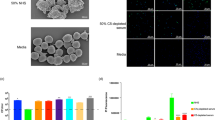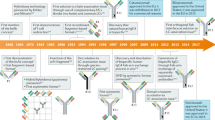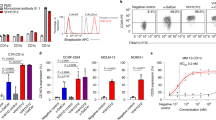Abstract
Monospecific antibody fragments produced in bacteria lack the Fc portion of antibodies, and are therefore unable to recruit natural effector functions. We describe the use of a bispecific antibody fragment (diabody) to recruit the whole spectrum of antibody effector functions by retargeting serum immunoglobulin (Ig). One arm of the diabody was directed against the target antigen, and the other against the serum Ig. The bispecific diabodies were able to recruit complement, induce mononuclear phagocyte respiratory burst and phagocytosis, and promote synergistic cytotoxicity towards colon carcinoma cells in conjunction with CD8+ T-cells. Further, by virtue of binding to serum Ig their half-life (β-phase) was increased fivefold compared to a control diabody of the same molecular weight. Such bispecific diabodies may provide an attractive alternative to monoclonal antibodies for serotherapy.
This is a preview of subscription content, access via your institution
Access options
Subscribe to this journal
Receive 12 print issues and online access
$209.00 per year
only $17.42 per issue
Buy this article
- Purchase on Springer Link
- Instant access to full article PDF
Prices may be subject to local taxes which are calculated during checkout
Similar content being viewed by others
References
Waldman, T.A. 1991. Monoclonal antibodies in diagnosis and therapy. Science 252: 1657–1662.
Neuberger, M.S., Williams, G.T., Mitchell, E.B., Jouhal, S.S., Flanagan, J.G., and Rabbitts, T.H. 1985. A hapten-specific chimeric IgE antibody with human physiological effector function. Nature 314: 268–270.
Jones, P.T., Dear, P.H., Foote, J., Neuberger, M.S., and Winter, G. 1986. Replacing the complementarity-determining regions in a human antibody with those from a mouse. Nature 321: 522–525.
Riechmann, L., Clark, M., Waldmann, H., and Winter, G. 1988. Reshaping human antibodies for therapy. Nature 332: 323–327.
Nose, M. and Wigzell, H. 1983. Biological significance of carbohydrate chains on monoclonal antibodies. Proc. Natl. Acad. Sci. USA 80: 6632–6636.
Walker, M.R., Lund, J., Thompson, K.M., and Jefferis, R. 1989. Aglycosilation of human lgG1 and lgG3 monoclonal antibodies can eliminate recognition by human cells expressing FcγRI and FcγRIII receptors. Biochem. J. 259: 347–352.
Winter, G., Griffiths, A.D., Hawkins, R.E., and Hoogenboom, H.R. 1994. Making antibodies by phage display technology. Annu. Rev. Immunol. 12: 433–455.
Cumber, A.J., Ward, E.S., Winter, G., Parnell, G.D., and Wawrzynczak, E.J. 1992. Comparative stabilities in vitro and in vivo of a recombinant mouse antibody FvCys fragment and a bisFvCys conjugate. J. Immunol. 149: 120–126.
King, D.J., Turner, A., Farnsworth, A.P.H., Adair, J.R., Owens, R.J., Pedley, R.B., et al. 1994. Improved tumor targeting with chemically cross-linked recombinant antibody fragments. Cancer Res. 54: 6176–6185.
Neuberger, M.S., Williams G.T., and Fox, R.O. 1984. Recombinant antibodies possessing novel effector functions. Nature 312: 604–648.
Holliger, P. and Winter, G. 1993. Engineering bispecific antibodies. Curr. Op. Biotech. 4: 446–449.
Peresics, O., Webb, P.A., Holliger, P.,, Winter, G., and Williams, R.L. 1994. Crystal structure of a diabody, a bivalent antibody fragment. Structure 2: 1218–1226.
Holliger, P., Prospero, T., and Winter, G. 1993. “Diabodies”: small bivalent and bispecific antibody fragments. Proc. Natl. Acad. Sci. USA 90: 6444–6448.
Mclntire, K.R. and Rouse, A.M. 1970. Mouse immunoglobulin light chains: alterations of the κ:λ ratio. Fed. Proc. Fed. Am. Soc. Exp. Biol. 29: 704–709.
Pound, J.D., Lund, J., and Jefferis, R. 1993. Human FcγRI triggering of the mononuclear phagocyte respiratory burst. Molec. Immunol. 30: 469–478.
Tomlinson, S. 1993. Complement defense mechanisms. Curr. Op. Immunol. 5: 83–89.
Holliger, P., Brissinck, J., Williams, R.L., Thielemans, K., and Winter, G. 1996. Specific killing of lymphoma cells by cytotoxic T-cells mediated by a bispecific diabody. Protein Eng. 9: 299–305.
Griffiths, A.D., Williams, S.C., Hartley, O., Tomlinson, I.M., Waterhouse, R., Crosby, W.L., et al. Winter, G. 1994. Isolation of high affinity human antibodies directly from large synthetic repertoires. EMBO J. 13: 3245–3260.
Brüggemann, M., Winter, G., Waldmann, H., and Nyeberger, M.S. 1989. The immunogenicity of chimeric antibodies. J. Exp. Med. 170: 2153–2157.
Perelson, A.S. 1989. Immune network theory. Immunol. Rev. 110: 5–36.
Yokota, T., Milenic, D.E., Whitlow, M., and Schlom, J. 1992. Rapid tumor penetration of a single-chain Fv and comparison with other immunoglobulin forms. Cancer Res. 52: 3402–3408.
Marks, J.D., Griffiths, A.D., Malmqvist, M., Clackson, T., Bye, J.M., and Winter, G. 1992. By-passing immunization: Building high affinity human antibodies by chain shuffling. Bio/Technology 10: 779–783.
Low, N., Holliger, P., and Winter, G. 1996. Mimicking somatic hypermutation: Affinity maturation of antibodies displayed on bacteriophage using a bacterial mutator strain. J. Mol. Biol. 260: 359–368.
Hoogenboom, H.R., Griffiths, A.D., Johnson, K.S., Chiswell, D.J., Hudson, P., and Winter, G. 1991. Muffi-subunit proteins on the surface of filamentous phage: methodologies for displaying antibody fab) heavy and light chains. Nucleic Adds Res. 19: 4133–4137.
Reth, M., Imanishi-Kari, T., and Rajewski, K. 1979. Analysis of the repertoire of anti(4-hydroxy-3-nrtrophenyOacetyl (NP) antibodies in C57 BL/6 mice by cell fusion. II. Characterization of idiotopes by monoclonal anti-idiotope antibodies. Eur. J. Immunol. 9: 1004–1013.
Smith-Gill, S.J., Meinhart, C.R., Lavoie, T.B., Rudikoff, S., and Potter, M. 1984. VH-VL expression by monoclonal antibodies recognizing avian lysozyme. J. Immunol. 132: 963–967.
Chester, K.A., Begent, R.H., Robson, L., Keep, P., Pedley, R.B., Boden, J.A., et al. 1994. Phage libraries for generation of clinically useful antibodies. Lancet 343: 455–456.
Orlandi, R., Gussow, D.H., Jones, P.T., and Winter, G. 1989. Cloning immunoglobulin variable domains for expression by the polymerase chain reaction. Proc. Natl. Acad. Sci. USA 86: 3833–3837.
Clackson, T., Hoogenboom, H.R., Griffiths, A.D., and Winter, G. 1991. Making antibody fragments using phage display libraries. Nature 352: 624–628.
Ward, E.S., Gussow, D., Griffiths, A.D., Jones, P.T., and Winter, G. 1989. Binding activities of a repertoire of single immunoglobulin variable domains secreted from Escherichia coli. Nature 341: 544–546.
McGuiness, B.T., Walter, G., Fitzgerald, K., Schuler, P., Mahoney, W., Duncan, A.R., et al. 1996. Phage diabody repertoires for selection of large numbers of bispecific antibody fragments. Nature Biotechnology 14: 1149–1154.
Pound, J.D., Lund, J., and Jefferis, R. 1993. Aglycosilated chimaeric human lgG3 can trigger the human phagocyte respiratory burst. Mol. Immunol. 30: 233–241.
Tutt, A.A., Stevenson, G.T., and Glennie, M.J. 1991. Trispecific F(ab')3derivatives that use cooperative signaling via the TCR/CD3 complex and CD2 to activate and redirect resting cytotoxic T cells. J. Immunol. 147: 60–69.
Bohlen, H., Manzke, O., Engert, A., Hertel, M., Altenburg, R., et al. 1994. Differentiation of cytotoxicity using target cells labelled with europium and samarium by electroporation. J. Immunol. Methods 173: 55–62.
Neri, D., Prospero, T., [Petral], H., Winter, G., Browne, M., and Vanderpant, L. 1996. Multipurpose High Sensitivity Luminescence Analyzer (LUANA): Use in gel electrophoresis. BioTechniques 20: 708–712.
Author information
Authors and Affiliations
Rights and permissions
About this article
Cite this article
Holliger, P., Wing, M., Pound, J. et al. Retargeting serum immunoglobulin with bispecific diabodies. Nat Biotechnol 15, 632–636 (1997). https://doi.org/10.1038/nbt0797-632
Received:
Accepted:
Issue Date:
DOI: https://doi.org/10.1038/nbt0797-632
This article is cited by
-
Therapeutic antibodies for autoimmunity and inflammation
Nature Reviews Immunology (2010)
-
Properties, production, and applications of camelid single-domain antibody fragments
Applied Microbiology and Biotechnology (2007)
-
Potent antibody therapeutics by design
Nature Reviews Immunology (2006)
-
Engineered antibody fragments and the rise of single domains
Nature Biotechnology (2005)
-
Antibodies come back from the brink
Nature Biotechnology (1998)



